In a marketplace where eCommerce and social media blend, social commerce emerges as a pivotal arena for marketers in 2024. This guide provides the crucial stats, trends, and tactics that marketers need to thrive in this integrated landscape.
We’ll dissect how social commerce is revolutionizing consumer engagement and sales and highlight success stories. Prepare to transform your strategy with our deep dive into the social commerce ecosystem.
What is social commerce?
Social commerce is a transformative fusion of eCommerce and social media, creating a digital space where shopping is integrated into the natural flow of social interaction. This innovative model enables a seamless transition from browsing to purchasing—right within a user’s favorite social platforms.
Market size and predictions
The financial trajectory of social commerce is striking, with its market size expected to reach a staggering US $1.95 trillion by 2026. Looking further ahead, the forecast suggests a climb beyond US $6 trillion by 2030, underlining the growing consumer shift towards social media as a retail hub.
eCommerce brands and consumer engagement
Forward-thinking eCommerce brands are capitalizing on social commerce’s capabilities to tap into a broad, active user base. This strategic move isn’t just about driving sales; it’s about embedding brands into the daily lives of consumers, thereby nurturing a deeper, more meaningful connection that transcends traditional online shopping experiences.
Why is social commerce important?
With over 4.5 billion social media users globally, social commerce is expanding at a pace faster than traditional eCommerce, indicating a shift in consumer purchasing behavior toward more integrated social experiences.
The growth is largely fueled by the creator economy, where influencers have become pivotal in shaping purchasing decisions, especially among Millennials and Gen Z, who are increasingly using social media for shopping inspiration and transactions. This shift represents not just a change in how people shop but where and who they trust, making social commerce a critical focus for modern eCommerce strategies.
Benefits of social commerce
1. Expanded audience reach
Social media is where Millennials and Gen Z like to shop
Millennials and Gen Z, who are known for their affinity for digital platforms, are increasingly turning to social media as their preferred shopping destination. With social media being an integral part of their daily routine, these demographics are prime targets for social commerce initiatives.
There are huge numbers of potential customers on social media
With billions of people using social media, the potential customer base for social commerce is enormous. This massive audience provides an unprecedented opportunity for brands to expand their reach and connect with new markets.
Expanding your target audience
The global reach of social media allows brands to extend beyond local markets, tapping into a worldwide audience. This expansion is vital for growth, especially as more users from diverse demographics continue to embrace social shopping.
2. Frictionless shopping experience
Social commerce removes friction
By minimizing the steps from discovery to purchase, social commerce platforms reduce friction and simplify the buying process. This ease of use encourages spontaneous purchases and can lead to higher conversion rates.
Convenient, frictionless buying
Features like in-app checkout and saved payment details make social commerce a highly convenient option for consumers. This hassle-free experience is particularly appealing to a market that values quick and effortless transactions.
Frictionless shopping experiences to boost customer loyalty
The streamlined purchasing process inherent in social commerce not only makes buying easier but also fosters customer loyalty. A frictionless experience leads to repeat purchases and long-term customer relationships.
3. Credibility via social proof
Increased reviews and recommendations through social proof
Social commerce platforms are ideal for generating and displaying social proof, such as reviews and recommendations, which play a critical role in the purchasing decisions of potential buyers.
User-generated content to build trust among shoppers
The integration of user-generated content (UGC), like comments and shares on social commerce platforms, helps build trust among shoppers. This social proof is a potent form of endorsement, encouraging others to buy with confidence.
4. Increased sales
Driving additional revenue to traditional eCommerce
Social commerce is proving to be a significant revenue driver, with projections indicating substantial growth in sales through these channels. The convenience and integrated nature of social commerce make it a lucrative complement to traditional eCommerce strategies.
You can sell to highly targeted audiences
The wealth of data available on social media users allows brands to target their advertising with precision, putting products in front of those most likely to be interested. This targeted approach is difficult to replicate in traditional eCommerce sales settings but is a natural fit within social commerce, thus driving up sales and engagement.
How does social commerce work?
Social commerce seamlessly merges eCommerce with social media, creating a shopping experience integrated into users’ everyday online interactions. It begins with product discovery, often triggered by engaging content shared by brands, influencers, or users. When users find an appealing product in their social feed, they can easily click on it, redirecting them to the product page.
On the product page, users find detailed information, images, and user-generated content like reviews, all within the same platform. This eliminates the need to visit external websites, streamlining the experience. For purchases, social commerce platforms often offer in-app checkout options, simplifying transactions. This frictionless journey from discovery to purchase is at the core of social commerce.
As users engage, their data informs personalized recommendations and targeted advertising. This data-driven approach enhances customer satisfaction while helping brands refine their marketing.
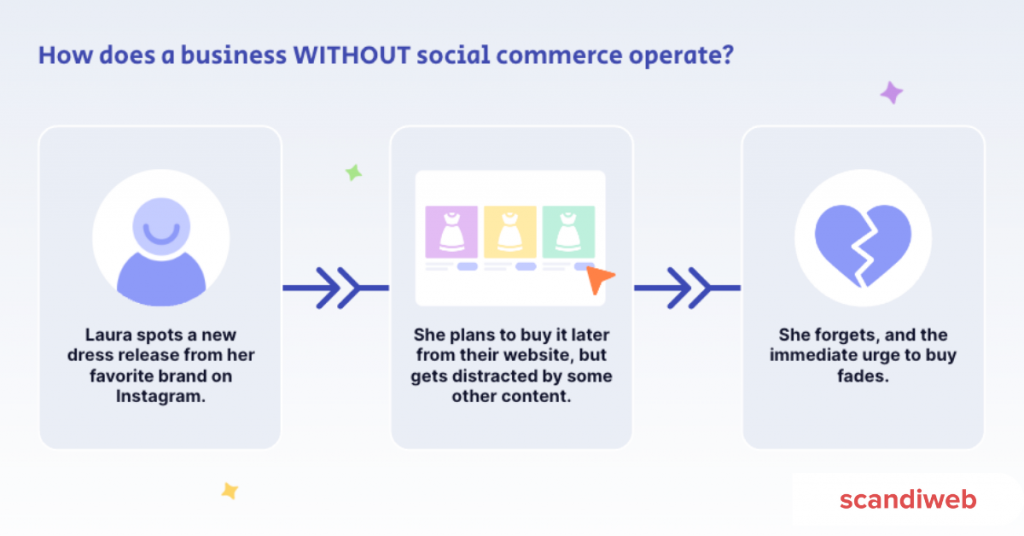
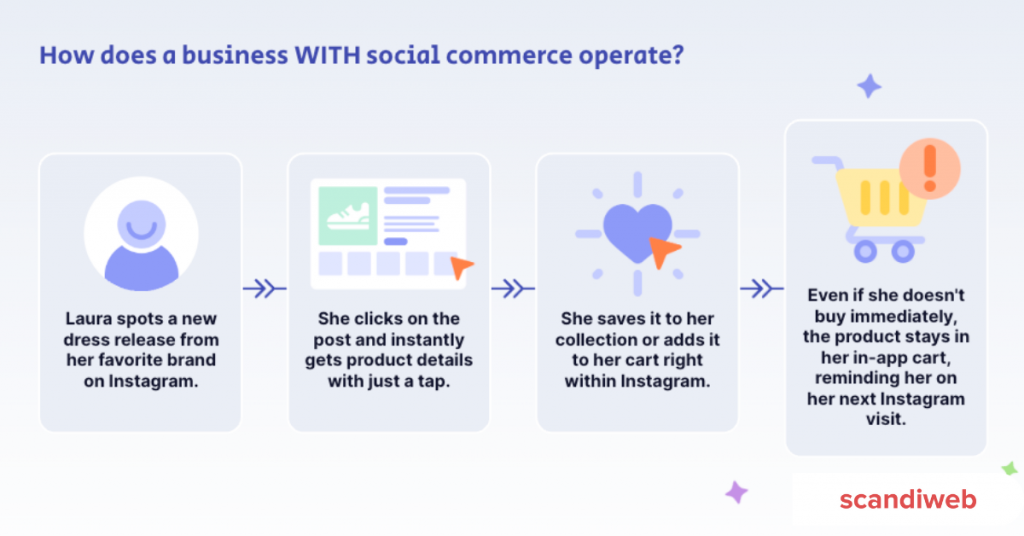
Main business objectives and challenges in social commerce
Business and digital objectives social commerce helps to reach:
- Reduce the cost of acquiring new customers
- Reach younger audiences who are heavily engaged with social media
- Calculate ROI from social media
- Increase sales and conversion rate, customers can make purchases without navigating away, reducing the number of steps from product discovery to purchase.
- Convert every social media touchpoint into genuine sales opportunities
- Diversify marketing and revenue streams
- Increase ROI from marketing campaigns by leveraging influencer partnerships and native sales-focused features of social platforms
- Increase customer engagement, interact in real-time (live shopping), answer questions, address concerns, and showcase products—leading to instant sales.
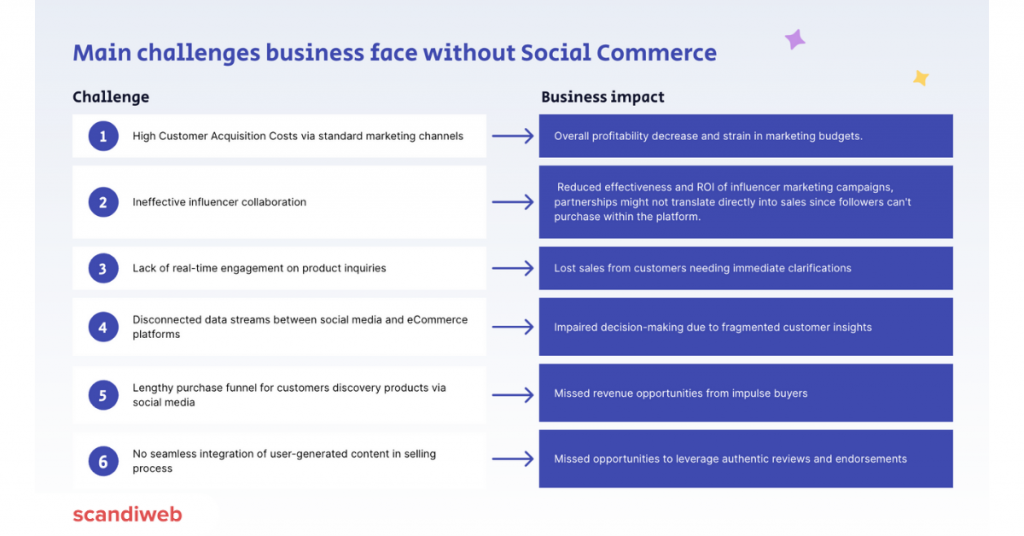
Evolution of social commerce
Social commerce: Before
In the earlier stages of social commerce, the landscape was vastly different from what we see today. It began with the simple integration of “Buy Now” buttons on social media platforms. When users clicked on these buttons or links, they were typically redirected to the merchant’s website to complete their purchase. The functionalities were limited, and the shopping experience was somewhat disjointed.
Before, social commerce primarily relied on traditional eCommerce platforms, with businesses using social media as a means to redirect users to their websites. While this provided a basic level of integration, it lacked the seamless, integrated experience that characterizes modern social commerce.
Social commerce: Now
Fast forward to the present, and social commerce has undergone a profound transformation. It’s no longer just about facilitating transactions but creating an entire shopping ecosystem within social media platforms. Features like in-app checkout, shoppable posts, live shopping events, and integrated customer support have become the norm.
Now, businesses can build their entire storefronts within social media apps, offering a frictionless shopping experience to users. Social commerce has also seen the rise of influencers and user-generated content, where real people’s recommendations and reviews play a pivotal role in shaping purchasing decisions. It’s a dynamic landscape where engagement and sales are seamlessly intertwined.
Social commerce: Next
Looking ahead, the evolution of social commerce is set to continue. The future promises even more immersive experiences, with augmented reality (AR) and virtual reality (VR) likely to play significant roles. Users might be able to try on products virtually or interact with them in innovative ways right within the social media platforms, enhancing the pre-purchase experience.
Moreover, the integration of AI and machine learning will enable businesses to offer highly personalized product recommendations and more targeted advertising. The line between social media and eCommerce will blur further, making shopping an integral part of our online social interactions.
Features of social commerce
Social commerce is rapidly transforming the way we think about online shopping. This section delves into some of the most exciting and influential aspects of social commerce today.
1. Live shopping
Live shopping combines the immediacy of live streaming with the convenience of online shopping. Brands and influencers use live video on social platforms to showcase products, conduct demos, and interact with viewers in real-time. This format not only boosts engagement but also allows for instant purchases, making it a powerful tool in the social commerce arsenal.
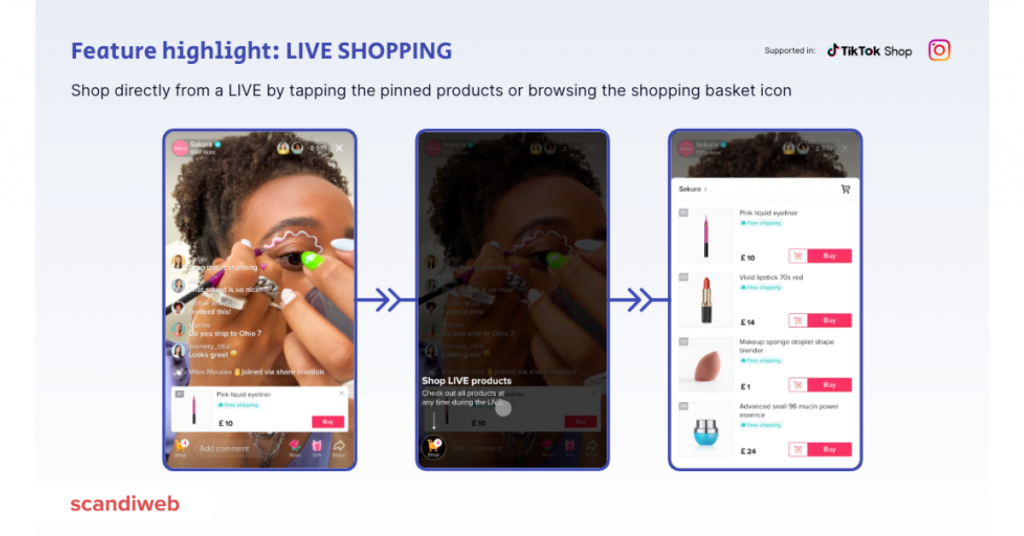
2. Shoppable photos and videos
Visual content on many social media sites has evolved from mere engagement tools to shoppable experiences. Platforms now allow users to click on photos and videos to view product details and make purchases without leaving the app. This seamless integration of shopping into everyday social browsing is changing how consumers discover and buy products.
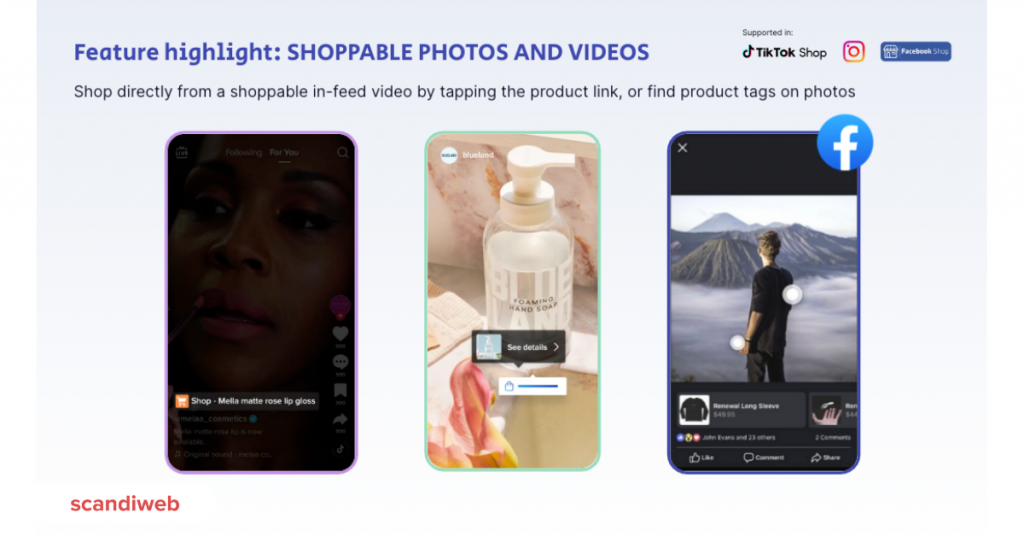
3. Shoppable ads
Shoppable ads are a game-changer in targeted advertising. These ads appear in social media feeds and stories, offering users the ability to shop for products and services directly from the ad. With sophisticated targeting capabilities, these ads reach potential customers based on their interests, behaviors, and previous interactions, enhancing the likelihood of conversion.
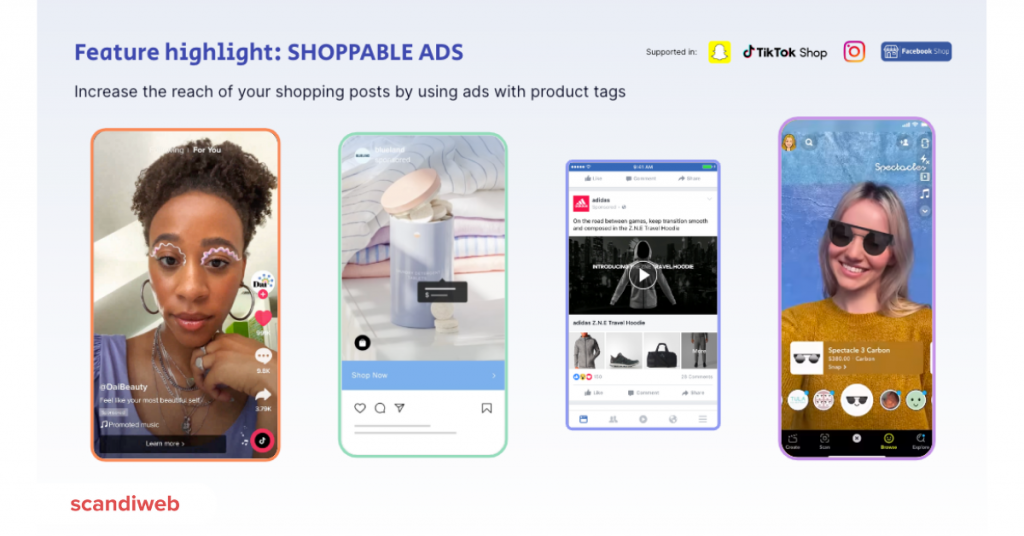
4. Product showcase
Social media platforms are becoming virtual showrooms where brands can display their products in a dynamic, interactive environment. Through features like product tags and catalogs, businesses can create a more immersive shopping experience that encourages users to explore and purchase.

5. Direct creator collabs
Collaborations between brands and social media creators are at the heart of a successful social commerce strategy. These partnerships leverage the creators’ influence and following to promote products in an authentic and relatable way. Such collaborations not only boost brand visibility but also build trust among the creator’s audience.
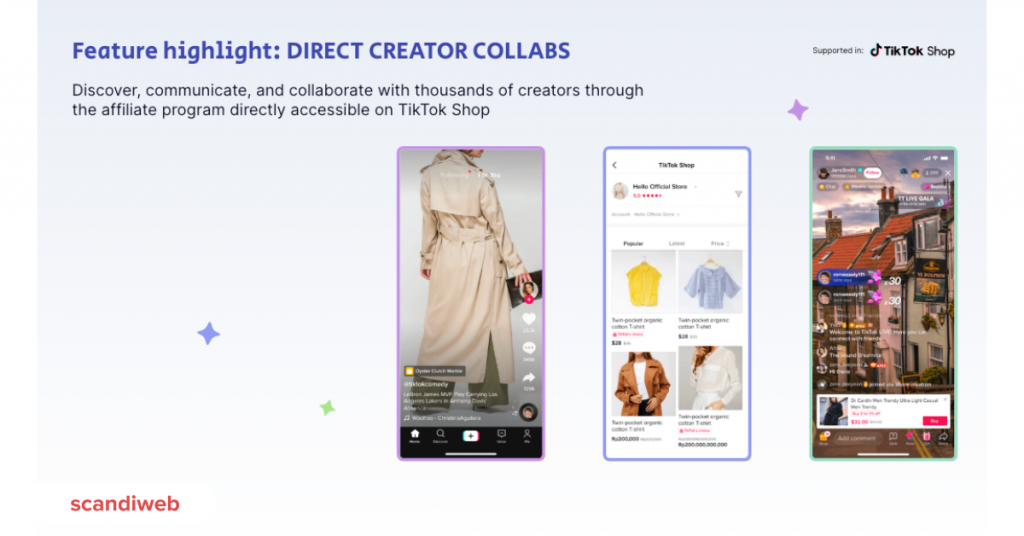
6. Launches
Product launches on social media channels are now events in their own right. Brands use these platforms to create buzz around new products, often through teasers, countdowns, and exclusive previews. This approach not only generates excitement but also allows for immediate feedback and engagement from potential customers.

7. Checkout
The integration of checkout processes directly within social media platforms marks a significant advancement in social commerce. This feature enables users to complete purchases without leaving the social media platform, streamlining the shopping experience and reducing the steps to conversion. It’s a critical component in making social commerce as frictionless as possible.
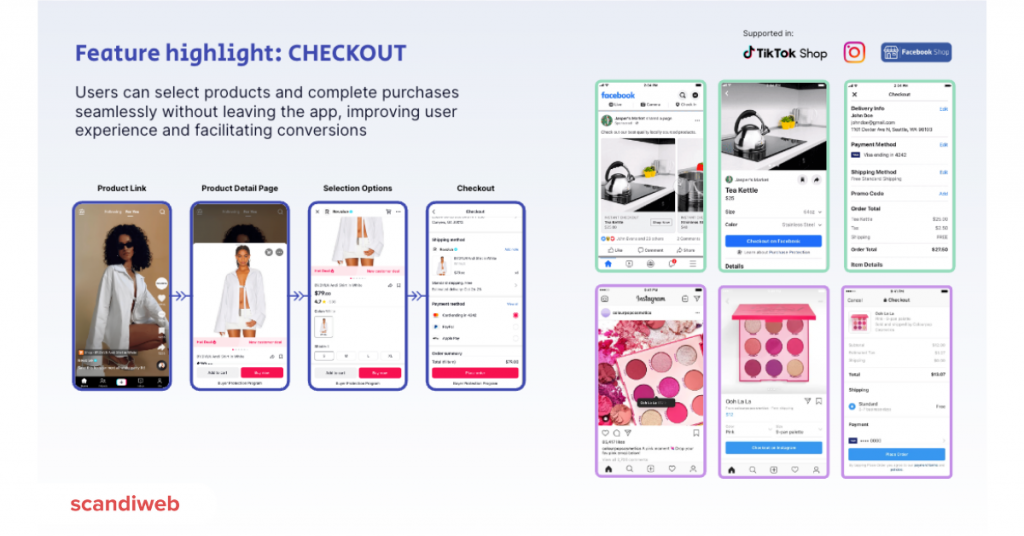
Solutions comparison in social commerce
Explore the various social commerce platforms by delving into more than just storefront integration. The real distinctions emerge in the advanced engagement features and unique user experiences that set them apart.
Let’s look at Facebook Shop, Instagram Shop, and TikTok Shop, comparing them across various dimensions such as user base size, audience age demographics, average CPC, and unique features, among others. This table will provide a clear overview of how each platform stands in the social commerce landscape, helping marketers and businesses make informed decisions about where to focus their efforts.
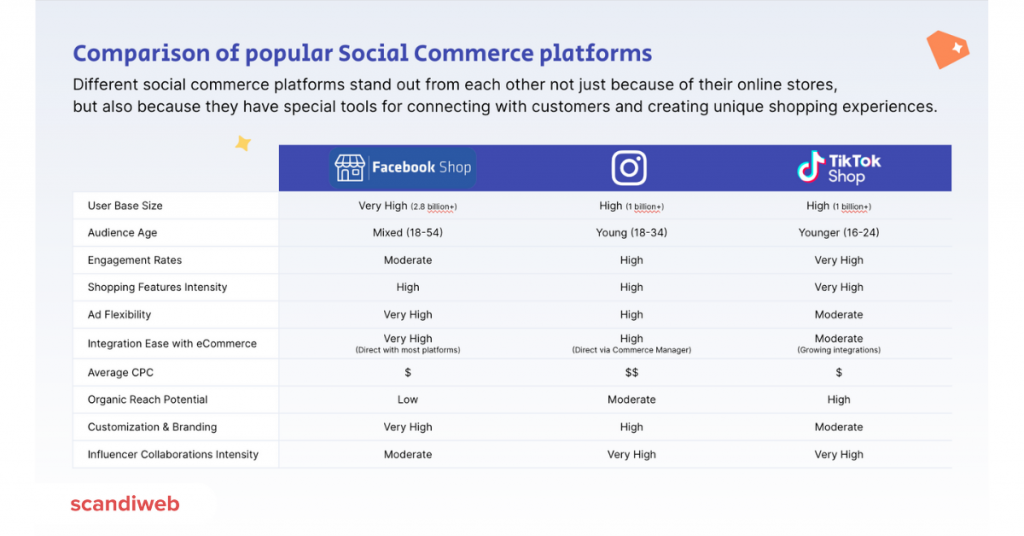
Instagram Shop: Pros, cons, best for
Pros
- Built as a visual platform, it’s ideal for showcasing products in engaging ways
- Seamless integration between posts, stories, and product pages allows for direct product tagging
- The dedicated shopping tab in the Explore section connects products with new audiences
- Users can purchase directly from the app, creating a frictionless buying experience
- Merchants can easily manage and sync their product catalog between Facebook and Instagram
Instagram’s strengths are rooted in its visual-centric approach, making it a compelling platform for brands with visually appealing products.
Cons
- Younger users primarily use it, which might not be suitable for all product types or target audiences
- Organic reach can be unpredictable, reliant on ever-changing algorithms
- Outside of shopping tags and bio, there’s a limitation on linking out, potentially hindering multi-channel strategies
- As the platform continues to evolve, businesses need to adapt and re-strategize regularly
- Like Facebook, transaction fees apply for each sale made within the platform
The challenges with Instagram arise from its specific user demographics and the platform’s inherent constraints, especially around linking.
When to choose
- When your target audience aligns with Instagram’s primary user demographic (younger, visual-first)
- If you have high-quality visual content to showcase products
- When looking for a platform that blends organic content and shoppable posts seamlessly
- If you want to tap into the influencer marketing ecosystem for product promotions
- When aiming for a frictionless purchase experience for mobile users
When not to choose
- If your target demographic skews much older or doesn’t engage with visual content
- When you require extensive outbound linking to other platforms or resources
- If your brand relies heavily on organic reach without much ad spend
- When you’re looking for in-depth analytics and data tracking beyond what Instagram provides
- If you want a more customizable storefront experience
Facebook Shop: Pros, cons, best for
Pros
- Facebook and Instagram provide a direct connection for unified shopping experiences
- Merchants can leverage Facebook’s massive audience to showcase products
- Advertisers can use Facebook’s ad targeting to display tailored product ads to potential customers
- Businesses can manage shops, ads, and analytics all within Facebook Business Suite
- It’s optimized for mobile shopping, which is essential as mobile commerce continues to grow
Facebook’s pros stem from its comprehensive ecosystem, allowing businesses to create, manage, and optimize their social commerce with a wide audience reach.
Cons
- Highly saturated market means brands have to invest significantly to stand out
- There are transaction fees for each sale made through the platform
- Fewer options are available for customizing the store compared to standalone eCommerce platforms
- Brands are at the mercy of any changes or decisions made by Facebook
- Some businesses and users have privacy concerns regarding Facebook’s data usage
Facebook’s cons arise from its position as a dominant social platform, leading to competition, and its broad-based approach, which sometimes lacks niche-specific functionalities.
When to choose
- When you’re targeting a broad audience, especially a mobile-centric one
- When you want to combine advertising and sales in a unified platform
- If you’re just starting with social commerce and need an easy entry point
- If you’re seeking a solution that simplifies the buying process by allowing direct purchases from ads
When not to choose
- When you require a highly customized storefront beyond Facebook’s offerings
- If you’re targeting a niche audience that doesn’t primarily use Facebook
- When you have concerns about data privacy and control
- If you’re not willing to pay transaction fees for each sale
- When your brand strategy involves diversifying across multiple platforms to reduce dependency on one
TikTok Shop: Pros, cons, best for
Pros
- TikTok’s algorithm often catapults products to viral status quickly
- Use of short, engaging video content for product promotions can be highly interactive
- Appeals significantly to Gen Z and younger millennials
- Users can make purchases without leaving the TikTok app
- Brands can collaborate with TikTok influencers directly for promotions
The primary strength of TikTok Shop lies in its viral content potential and deep resonance with younger audiences.
Cons
- Content lifespan is short-lived; what’s trending today might not be trending tomorrow
- The audience primarily consists of younger users, which may not fit all product types
- To consistently stay in front of audiences, there might be a reliance on ad spend
- As a newer platform, some features may still be evolving
- Brands need to adapt to TikTok’s unique video format and trends, which requires continuous content creation efforts
TikTok’s challenges mainly stem from its rapid content cycle and the need to consistently create engaging, trend-focused content.
When to choose
- When your brand can adapt to quick, engaging video content creation
- If you want to harness the potential of viral content for product promotions
- For brands that want to engage in influencer partnerships seamlessly
When not to choose
- If your target audience doesn’t align with TikTok’s younger demographic
- When you seek a more stable, long-term content strategy without frequent changes
- If you’re not prepared for rapid content creation in tune with trending topics
- For brands that prefer more traditional or static content formats
- If you need in-depth analytics or a mature platform with years of proven results
Case Studies: Successful social commerce campaigns
Case study 1: Beauty Works turns to TikTok Shop to leverage its multi-million follower base
Business case
Beauty Works is a perfect example of influencers-driven eCommerce with its army of social media fans and highly influential brand ambassadors.
They were invited to participate in the TikTok Shop UK beta launch before the official opening. Having a very active follower base in TikTok beforehand, Beauty Works recognized that it was an important strategic move to start monetizing social traffic better.
Approach and results
- Set up a product feed to sync the product catalog from Adobe Commerce to TikTok Shop for up-to-date product information on both channels
- Launch shoppable ads to engage target audience who are not followers yet
- Sync orders back from TikTok to Adobe Commerce to keep a single source of truth for orders information
- Initiate influencer collaborations with direct TikTok Shop integration covering 100M+ audience
- 96% of traffic was generated from mobile devices
Case study 2: Rareseeds gets +791% revenue from social commerce campaigns
Business case
Rareseeds is North America’s largest heirloom seed company. They were looking for a new marketing strategy on digital channels to reach new audiences, leverage their existing 1M+ followers, and increase the return from ad spend on all channels.
The inclusion of direct checkout on social networks was regarded as a pivotal feature in boosting sales through social commerce, as it streamlines the purchasing process and reduces the number of steps required to complete a transaction.
Approach and results
- Set up a product feed to sync the product catalog from Magento to Facebook, Instagram, and TikTok Shop
- Initiate dynamic ads highlighting products with the highest marginality on Facebook and Instagram
- Announce new product launches on Instagram with native product tags
- Sign creator collaborations directly on TikTok
- Conduct TikTok Ads experiments with all available formats
- +791% revenue growth from paid campaigns was seen as a result
Social commerce trends
Expanding your presence in the ever-evolving landscape of social commerce means keeping a finger on the pulse of emerging trends and technologies. As consumer behavior shifts and new opportunities arise, businesses must remain agile and adaptable. Here, we’ll explore the latest social commerce tools and trends that are shaping the way brands connect with their audiences and drive sales.
People engage with more AR experiences
Augmented Reality (AR) is becoming a game-changer in the world of social commerce. As consumers seek immersive and interactive shopping experiences, AR provides a powerful tool. With AR, users can visualize products in their own environment before making a purchase. For example, they can virtually try on clothing, see how furniture fits in their home, or even test makeup products in real-time through AR filters.
This trend extends beyond just fun and engaging experiences. It addresses a critical consumer need—the ability to assess products more thoroughly before committing to a purchase. Businesses that embrace AR in their social commerce strategies not only offer a novel shopping experience but also enhance customer confidence and reduce the likelihood of returns.
Incorporating AR into your social commerce arsenal can set your brand apart and create a memorable shopping journey. Keep an eye on this trend as it continues to gain momentum, and consider how it can be integrated into your own social commerce strategy to engage and delight your audience.
Video shopping takes center stage
Video content has always been a powerful tool for engaging audiences, but in the realm of social commerce, it’s gaining even more prominence. Live streaming and video shopping events are becoming increasingly popular. Businesses are leveraging platforms like Facebook Live, Instagram Live, and TikTok Live to showcase their products in real-time, answer questions from viewers, and drive immediate sales.
This trend taps into the desire for authentic and interactive shopping experiences. When customers can see products in action, ask questions, and receive immediate responses, it builds trust and confidence in their purchasing decisions. The combination of live video and shopping features allows for a dynamic and engaging shopping journey that can rival the in-store experience.
To stay competitive, consider incorporating live video shopping into your social media marketing and commerce strategy. This not only provides an avenue for showcasing your products but also enables real-time customer interaction, creating a sense of urgency and excitement around your brand.
Sustainability and ethical shopping
Consumers are becoming increasingly conscious of the environmental and ethical impact of their purchases. Social commerce is reflecting this shift by giving businesses the opportunity to highlight their commitment to sustainability and ethical practices. Brands that can transparently communicate their eco-friendly initiatives, fair labor practices, and ethical sourcing stand to gain a competitive edge.
Incorporating sustainability and ethics into your social commerce strategy involves not only the products you offer but also the messaging and values your brand conveys. Customers are more likely to support businesses that align with their values, so consider how your brand can contribute to a more sustainable and ethical consumer landscape.
Social commerce integration with messaging apps
Messaging apps are no longer just platforms for communication; they are becoming integral to social commerce. Businesses are increasingly utilizing messaging apps like WhatsApp, Facebook Messenger, and WeChat to interact with customers, provide real-time customer support, and even facilitate transactions. These apps offer a more personal and convenient way to connect with consumers, fostering trust and loyalty.
By integrating messaging apps into your social commerce strategy, you can create a seamless and conversational shopping experience. Customers can inquire about products, receive recommendations, and make purchases directly within the messaging app. This trend aligns with the broader shift toward conversational social commerce capabilities, where brands engage customers through natural, chat-based interactions.
Micro-moments and mobile-first shopping
Mobile devices continue to dominate the social commerce landscape. Consumers are increasingly turning to their smartphones for quick and on-the-go shopping experiences. Businesses that optimize their social commerce strategies for mobile devices can capture these micro-moments when customers make quick purchasing decisions.
To leverage this trend, ensure that your website and social commerce platforms are mobile-responsive, load quickly, and offer a seamless mobile shopping experience. Emphasize the convenience and efficiency of shopping via mobile, enabling customers to browse, compare, and purchase effortlessly.
User-generated content and authenticity
User-generated content (UGC) remains a powerful tool for building trust and authenticity in social commerce. Encouraging customers to share their experiences and reviews can lead to more genuine connections with potential buyers. Businesses that actively seek and promote UGC can tap into the collective wisdom and influence of their customer community.
Consider ways to integrate UGC into your social commerce strategy, such as featuring customer reviews, user-generated photos, and testimonials. This not only builds trust but also showcases your products in real-life situations, helping potential buyers visualize their own experiences.
These trends represent just a snapshot of the rapidly evolving social commerce landscape. Staying informed about these and other emerging trends will be key to growing your presence in new social channels and marketplaces, and meeting the evolving needs and expectations of your customers.
Wrapping up
In 2024, social commerce stands as a pivotal arena where eCommerce and social media converge. This guide equips you with essential insights for thriving in this integrated landscape, emphasizing the transformative fusion of eCommerce and social interaction. With a market poised to reach staggering figures, social commerce’s significance is undeniable, driven by the influence of the creator economy and the shift in consumer purchasing behavior toward integrated social experiences.
Frequently asked questions
What are the benefits of social commerce for eCommerce brands?
Social commerce offers expanded reach, frictionless shopping experiences, and credibility through social proof, leading to increased sales and deeper consumer engagement.
How does social commerce work?
Social commerce integrates eCommerce into social media platforms, offering in-app checkout and personalized, streamlined shopping from discovery to purchase.
What are the latest trends shaping social commerce?
Trends include AR experiences, video shopping, sustainability, integration with messaging apps, mobile-first shopping, and the emphasis on user-generated content for authenticity.
What are the top social commerce platforms in 2024?
The top social media platforms for eCommerce in 2024 are TikTok, Instagram, and Facebook.
Ready to transform your social commerce strategy? Let’s chat! Reach out to us for expert guidance and unlock the full potential of your online business. Your success story begins with a simple click.

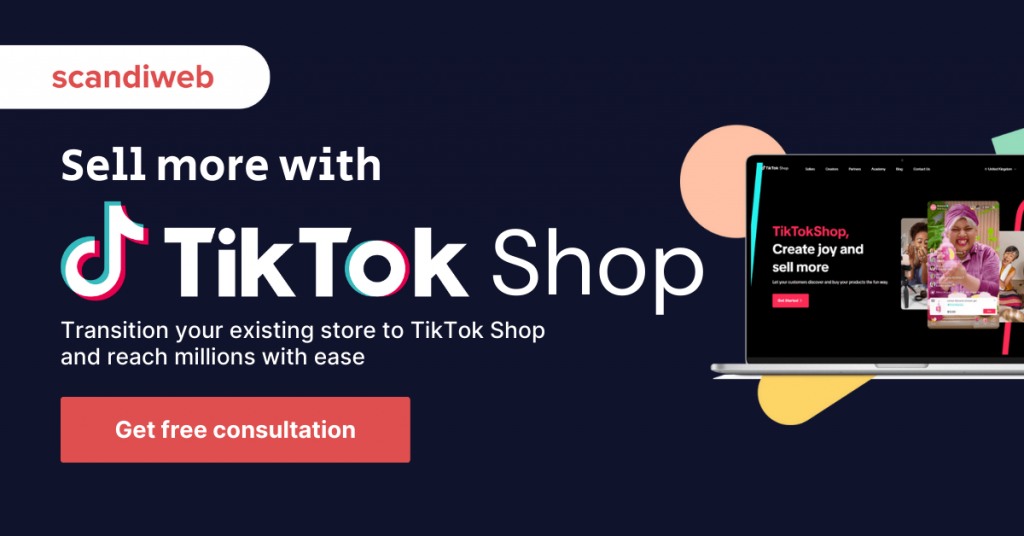





Share on: